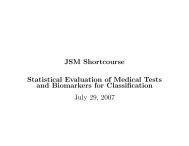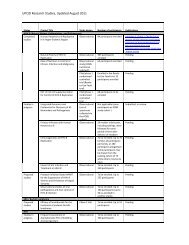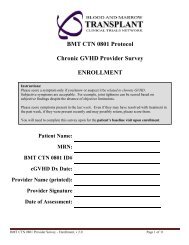Summer Undergraduate Research Program - Fred Hutchinson ...
Summer Undergraduate Research Program - Fred Hutchinson ...
Summer Undergraduate Research Program - Fred Hutchinson ...
You also want an ePaper? Increase the reach of your titles
YUMPU automatically turns print PDFs into web optimized ePapers that Google loves.
Uncovering the Neural Circuitry in Fear<br />
Joshua Onyango 1 Kunio Kondoh 2 and Linda B. Buck 2<br />
<br />
2012 Best Poster Presentation Award<br />
Results cont’d<br />
Methods<br />
Abstract<br />
Figure 2: CRHiresCre Mice<br />
<br />
<br />
<br />
<br />
changes mediated by the hypothalamic-pituitary-adrenal (HPA) axis. The HPA axis is activated<br />
by the release of corticotropin releasing hormone (CRH) from CRH neurons in the paraventricular<br />
nucleus (PVN) of the hypothalamus. CRH causes secretion of adrenocorticotropic hormone<br />
<br />
cortex. Previous studies have linked dysregulation of the HPA axis to a number of human<br />
<br />
responses as well as human health. The mechanisms and neural circuits that regulate the HPA<br />
axis are still unclear. To obtain anatomical and molecular insight into regulatory mechanisms in<br />
<br />
retrogradely through chains of connected neurons to infect neurons upstream of CRH neurons.<br />
The virus-infected neurons were analyzed for their locations and for markers of excitatory or<br />
<br />
hybridization to detect markers of excitatory glutamatergic or inhibitory GABAergic inhibitory<br />
<br />
hypothalamus that are upstream of CRH neurons and express a marker of excitatory neurons.<br />
<br />
regulating the HPA axis.<br />
Cre-dependent<br />
PRV<br />
Retrograde transport<br />
PVN<br />
CRH neuron<br />
(Cre expression)<br />
Introduction<br />
Figure 3: Bartha Strain of PRV<br />
<br />
-<br />
<br />
<br />
113<br />
Figure 6: Neurons likely to be directly upstream of CRH neurons<br />
hybridization were analyzed. Virus-infected cells (HA+) and<br />
<br />
SCh <br />
Scp <br />
SPa <br />
hypothalamus<br />
StA <br />
SubC <br />
SubI <br />
SuMM <br />
TC - Tuber cinerium area<br />
Tz - Nucl of the trapezoid body<br />
VDB - Nucl of the vertical limb of the<br />
diagonal band<br />
VMH - Ventromedial hypothalamic nucl<br />
VMPO - Ventromedial preoptic nucl<br />
MPA/O - Medial Preoptic area/nucl<br />
Mtu - Medial tuberal nucl<br />
PAG/Dk <br />
<br />
PH - Posterior hypothalamic area<br />
Pir - Piriorm cortex<br />
PM - Premammillary nucl<br />
PnC <br />
part<br />
PS - Parastrial nucl<br />
Pv - Periventricular ber system<br />
PV - Paraventricular thalamic nucl<br />
PVN - Paraventricular Nucl<br />
RCh - Retrochiasmatic area<br />
Re - Reuniens thalamic nucl<br />
Fi - <br />
HDB - Nucl of the horizontal limb of<br />
diagonal band<br />
InC <br />
LA - Lateroanterior hypothalamic nucl<br />
LDTg - Laterodorsal tegmental nucl<br />
LH - Lateral hypothalamic area<br />
LPB - Lateral parabrachial nucl<br />
LPGi - Lateral paragigantocellular nucl<br />
LS<br />
MA3 - medial accesory oculomotor nucl<br />
Me5 - Mesencephalic trigeminal nucl<br />
Maopt - Medial accesory optic tract<br />
MeA - Medial amygdaloid nucleus<br />
MnPO - Median preoptic nucl<br />
Abbreviations<br />
AcB -Acumbens nucleus<br />
ADP - Anterodorsal preoptic nucl<br />
AH - Anterior hypthalamic area<br />
AMP - Anteromedial thalamic nucl<br />
Arc - Arcuate hypothalamic nucl<br />
AVPe - Anteroventral periventricular<br />
nucl<br />
BL - Basolateral amygdaloid nucl<br />
BM - Basomedial amygdaloid nucl<br />
BST<br />
DM <br />
nucl<br />
DRI<br />
DTM<br />
nucl<br />
EW <br />
<br />
<br />
<br />
increased heart rate and cognitive alertness.<br />
- An understanding of the characteristics of neural inputs to the CRH neurons in<br />
mice could lead to a better understanding of the neural circuits involved in fear.<br />
This knowledge could also reveal information relevant to the HPA axis and<br />
stress-related pathologies in humans.<br />
<br />
connections to the CRH neurons and whether neurons upstream of CRH neurons are likely to<br />
transmit excitatory or inhibitory signals to CRH neurons.<br />
<br />
-<br />
stream neurons.<br />
Conclusions<br />
Figure 4: A Flowchart of the procedures used for the experiments;<br />
<br />
neurons in the virus-infected neurons.<br />
Neurons likely to be directly upstream of CRH neurons are detected in a number of regions<br />
of the hypothalamus<br />
The number of virus-infected neurons was low. More experiments are therefore needed<br />
to draw conclusions.<br />
<br />
(Vglut+) glutamatergic neurons.<br />
Results<br />
HA+ Vglut 1/2+ Merge (HA+ Vglut+)<br />
Acknowledgments<br />
binase<br />
in order to replicate and<br />
<br />
<br />
mice (CRHiresCre mice) that<br />
exress Cre recombinase in CRH<br />
<br />
<br />
studies from the Buck Lab<br />
suggest that direct presynaptic<br />
connections to the CRH neurons<br />
<br />
<br />
CRH Neurons<br />
(PVN)<br />
CRH<br />
Pituitary<br />
ACTH<br />
Adrenal<br />
Cortex<br />
<br />
<br />
<br />
<br />
<br />
<br />
HA+ <br />
Corticosteroids<br />
Physiological changes<br />
<br />
References<br />
Figure 1: HPA Axis<br />
<br />
from the pituitary causes the release of cortisol (humans)/ corticosterone (mice) from the adrenal cortex. These hormones lead to<br />
physiological changes associated with fear.<br />
<br />
<br />
<br />
<br />
<br />
Figure 5: <br />
<br />
To determine if neurons upstream of CRH neurons express markers of<br />
excitatory glutamatergic neurons or inhibitoryGABAergic neurons.<br />
Objective:
















